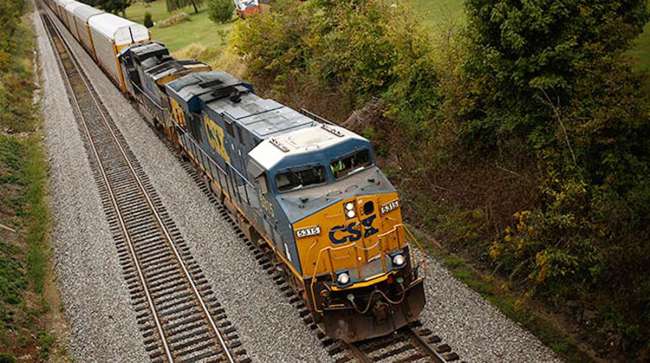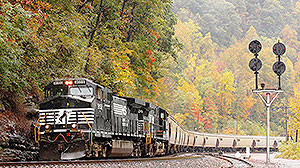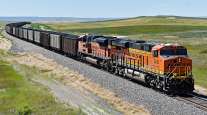Senior Reporter
With Capacity to Spare, Railroads Have an Eye on Truck Cargo

[Stay on top of transportation news: Get TTNews in your inbox.]
A recent remark by a senior official with CSX Transportation on a third-quarter earnings call with financial analysts has caught the attention of trucking industry leaders.
The statement by Mark Wallace, executive vice president of sales and marketing for Jacksonville, Fla.-based CSX, comes when most Class 1 freight railroads are reporting softer earnings but improvements in the way they operate their railroads, and there is excess capacity to move goods.
Consumers say they will spend an average of $1,047.83 this holiday season, up 4 percent from the $1,007.24 they said they would spend last year, according to NRF and @ProsperInsights holiday survey. https://t.co/mIu63tkdWw pic.twitter.com/3bjOUOQUqo
— National Retail Federation (@NRFnews) October 24, 2019
Rail officials acknowledged on their third-quarter financial calls they have extra capacity because they are not carrying as much freight as they did in 2017 and 2018, when the economy was roaring.
“There’s a lot of truck volume out there, and we believe by renewing our focus on the merchandise segment and looking for truck-conversion opportunities, that we’re going to capture that market share,” Wallace said. “Hopefully, people order a lot of stuff online, and we have the pleasure and honor of moving a lot of that stuff in the fourth quarter.”
Wallace’s statement comes as shippers are rushing to get hundreds of millions of dollars of items to warehouses and stores in anticipation of the holiday shopping season. The National Retail Federation said in its 2019 Winter Holiday Trends report it expects consumer spending to increase by more than $50 per person when compared with last year.
The railroads have extra capacity because, economists say, the manufacturing sector is slumping. Shipments are down for autos, coal, grain, chemicals and consumer goods, with crude oil the only bright spot. Rail carloads and intermodal units for large U.S. railroads were down 8.6% the week ending Oct. 19 to 507,381 units, according to the weekly report from the Association of American Railroads. Rail carloads were 245,002, down 7.8%, and intermodal volume was 262,379 for containers and trailers, down 9.3% from the same period a year ago.

Norfolk Southern
Class I carrier Norfolk Southern reported coal shipments in the third quarter were down 12%, to $403 million from $464 million in 2018, as more electric power plants shift away from coal, especially along the East Coast and Midwest, where Norfolk Southern operates.
“The railroads also suffer a lot when the mining sector does not do well, whether it’s coal, iron ore or the transport of fracked oil,” said Rajeev Dhawan, director of the Economic Forecasting Center at Georgia State University in Atlanta. “Once more pipelines come online, there will be more oil moved that way, rather than the costly rail. That’s why their businesses are not doing well, and they will look for alternatives. They have the capacity; they have cars.”
The railroad’s slump is a big turn from 2018, when rising shipments of autos, coal, lumber, chemicals and other commodities spurred U.S. rail carloads to rise 3.6%.
So now, railroads are looking for other sources of freight.
“At the same time, they are complaining about not having the same carloads of coal, and things like that, it is really important that they find other sources of revenue,” said Randy Mullett, president of Mullett Strategies and a former executive at XPO Logistics. “The problem is that coal cars can’t be used to haul furniture and other items.”
Tyler Rushford, executive director of Intermodal Motor Carriers Conference, said, “I think the railroads’ theory is there is always some margin, that we can take away from trucks. I think they eternally believe that.
“Privately they say that, or think that all of the time, and now it’s creeping into what they say to analysts.”
Freight carried by longhaul trucking is growing as consumer spending holds up.
However, truck cargo prices, when compared with 2018 levels, have cooled, and the cheaper rates are pulling some freight from rails. Last year, trucking moved 70.2% of tonnage carried by all modes of domestic freight transportation, including manufactured and retail goods.

Mullett
Mullett and other experts believe trucking has one huge advantage over rail, especially as e-commerce becomes a much more significant portion of the economy, and trucking moves to a more regional-based system of delivery. Trucks are mobile and can go almost anywhere, while railcars can only go point to point.
“Ultimately, it’s going on a truck. Those guys, the rails, aren’t going to the back of a Walmart or a Target,” Rushford said. “I think the rails are going to have to make big investments if they’re going to be more nimble in the intermodal space.”
Said Mullett: “More and more things are going to smaller shipments and dedicated on time, rather than bulk, and that’s a growing segment of the market, and most of the areas they work in are not growing, like coal.
“People are not going to rush to them and increase their supply chains. They are held hostage by their network. What they’re doing is what all monopolies do, and that is control capacity and extract rates. That’s what they’re excellent at. That’s no way to run a railroad long term.”
Want more news? Listen to today's daily briefing:




